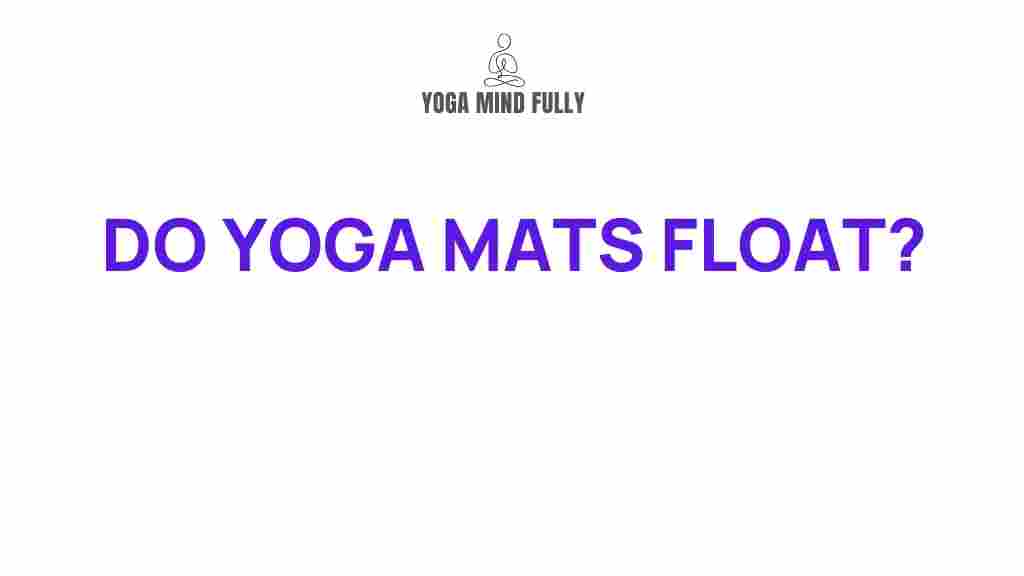Home > Yoga Essentials > Can Yoga Mats Float?
Can Yoga Mats Float?
Yoga mats are essential companions for every yoga practitioner, offering comfort, support, and grip. But have you ever wondered, can yoga mats float? While yoga is traditionally practiced on solid ground, some modern yoga styles, such as aqua yoga, incorporate water-based practices. Understanding the buoyancy of yoga mats opens doors to creative and therapeutic yoga routines.
Understanding the Materials: What Makes Yoga Mats Float?
Yoga mats are typically made from materials like PVC, TPE, natural rubber, or cork. These materials differ in their density and buoyancy, influencing whether or not a yoga mat can float. Let’s break it down:
- PVC Yoga Mats: PVC (Polyvinyl Chloride) mats are lightweight and often hollow, giving them moderate buoyancy. However, they may absorb water over time, affecting their ability to float.
- TPE Yoga Mats: Thermoplastic Elastomer (TPE) mats are known for being lightweight and eco-friendly. Their structure often makes them more likely to float.
- Natural Rubber Mats: These mats are heavier and denser, making them less buoyant. While they might float initially, they tend to sink after prolonged water exposure.
- Cork Yoga Mats: Cork mats are naturally water-resistant and buoyant, making them ideal for aquatic yoga practices.
The key to determining whether a yoga mat floats lies in its material composition and density. Mats designed for water-based yoga are specifically crafted to maintain buoyancy.
How to Test If Your Yoga Mat Can Float
If you’re curious about the buoyancy of your yoga mat, follow this simple test:
- Fill a bathtub or any large container with water.
- Place your yoga mat gently on the water’s surface.
- Observe if the mat stays afloat. Check if it submerges partially or entirely after a few minutes.
Ensure your mat is dry and clean before testing. This method is a quick way to see how your yoga mat performs in water-based scenarios.
Practical Applications for Floating Yoga Mats
Floating yoga mats open up exciting possibilities for yoga enthusiasts. Here are some innovative ways to use them:
- Aqua Yoga: Aqua yoga combines yoga poses with the calming effect of water. Using a buoyant mat ensures stability and enhances the experience.
- Water Therapy: Floating yoga mats can be incorporated into hydrotherapy sessions, offering relaxation and support for therapeutic exercises.
- Outdoor Adventures: Lightweight, floating mats are ideal for beach yoga or poolside practices, blending nature and fitness seamlessly.
Want to learn more about integrating yoga into your daily life? Check out our comprehensive yoga guide.
Troubleshooting: Why Your Yoga Mat Might Not Float
If your yoga mat isn’t floating as expected, consider these potential issues:
- Material Density: Heavier mats, such as those made of natural rubber, are less likely to float.
- Water Absorption: Some mats absorb water over time, reducing their buoyancy.
- Wear and Tear: Older mats with surface damage may lose their ability to stay buoyant.
If buoyancy is critical for your practice, invest in a mat specifically designed for water-based activities.
Choosing the Best Floating Yoga Mat
When selecting a floating yoga mat, consider the following features:
- Material: Look for mats made of cork or TPE, as they are more buoyant.
- Thickness: Thicker mats tend to float better due to increased air pockets.
- Durability: Opt for water-resistant and durable options to ensure longevity.
To make an informed decision, explore reputable brands offering specialized yoga mats. For more details, visit this Yoga Journal guide on yoga essentials.
Maintenance Tips for Water-Based Yoga Mats
Proper care extends the lifespan of your yoga mat, especially if you use it in water. Follow these maintenance tips:
- Rinse your mat with fresh water after each water-based session.
- Allow it to air dry completely before storing it to prevent mold and mildew.
- Avoid exposing your mat to direct sunlight for prolonged periods, as it can weaken the material.
Regular maintenance ensures your yoga mat remains functional and buoyant for years to come.
Conclusion
So, can yoga mats float? The answer depends on their material, density, and design. Whether you’re exploring aqua yoga, water therapy, or simply experimenting with new practices, understanding your yoga mat’s buoyancy opens up a world of possibilities. Select the right mat, care for it properly, and enjoy the serene blend of yoga and water.
Explore our other articles on yoga essentials and techniques to deepen your practice. Start your journey today!
This article is in the category Yoga Practices and created by YogaMindFully Team
